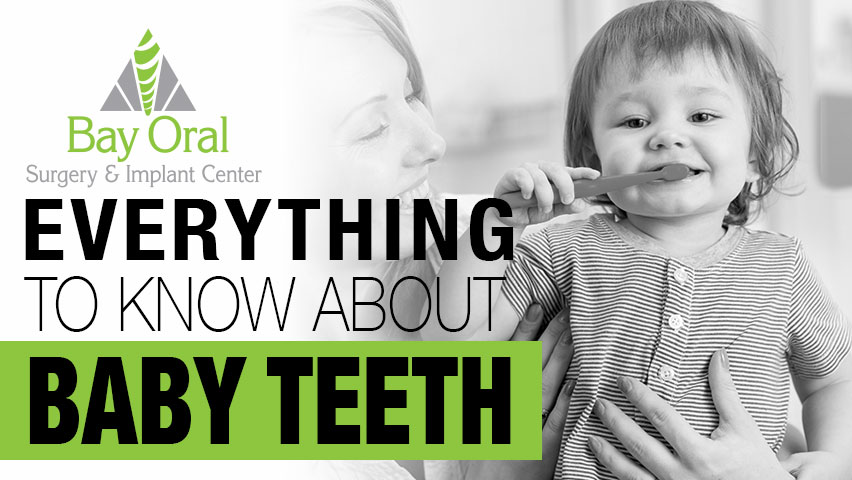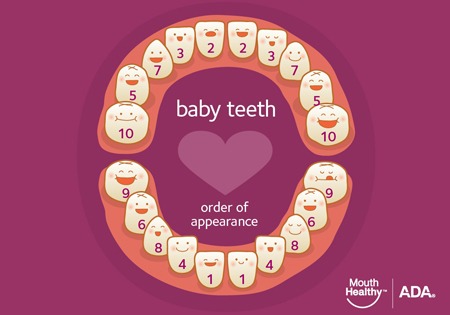
If you have a baby or toddler, it’s important to know what to expect when it comes to their primary (or baby) teeth. Here is a simple guide with everything you need to know about baby teeth.
How many baby teeth are there?
There are typically 20 baby teeth—10 on top and 10 on bottom. However, it is possible for some children to be missing some of their baby and/or adult teeth.
When will baby teeth start coming in?
Baby teeth typically begin to erupt between 6 months to 1 year, and most children will have their full set of baby teeth by the time they are 3 years old.
Is there a certain order in which they appear?
Yes, there is a typical order for teeth to appear, but every child is different so it’s possible that some may not follow this exact order. Typically the front two bottom teeth (central incisors) are the first to appear with the front two top teeth to follow. Here is a great visual from the ADA as well as a link to a very helpful baby teeth eruption chart (click here):
What can help with teething?
It’s not surprising that it is painful for teeth to cut through the gums, so this can cause sore and tender gums in babies. Teething can sometimes also be accompanied by drooling and low-grade fevers. Some ways you can help soothe the pain is by rubbing your child’s gums with a clean finger or a small, cool spoon or giving them a teething ring or toy that has been frozen or refrigerated to chew on. If your child is still cranky, a dose of infant’s or children’s pain reliever may help, but you should consult with your dentist or doctor for the best course of action and for the correct dosage amount based on your child’s age and weight.
When and how to care for baby teeth?
You should start caring for your child’s gums/teeth from the very start. Even before they have teeth, you should clean your baby’s mouth by wiping the gums with a clean, moist washcloth.
As soon as teeth appear you should begin brushing their teeth with a children’s toothbrush using fluoride toothpaste with an amount about the size of a grain of rice. Brush twice a day to establish good habits when they are young. When they start brushing on their own, you should supervise to ensure they are using the correct amount of toothpaste. It is important that they do not use too much and that they do not swallow it.
For children ages 3 to 6, they should use a pea-sized amount of fluoride toothpaste, also brushing twice a day.
Once your child has two teeth that touch you can also begin flossing between their teeth daily.
When to go to the dentist for the first time?
You should take your child to the dentist by age one or within six months of when the first tooth erupts. At the first visit the dentist can check for cavities, examine their teeth/gums and show you how to care for their teeth properly. You may want to consider seeing a pediatric dentist as they specialize in kids and typically make the overall experience more enjoyable for children.
What happens if baby teeth get a cavity?
Even though baby teeth are temporary, it’s still very important to care for them and have cavities treated to ensure they last as long as possible. Untreated cavities can also cause toothaches or infections. Baby teeth are important for a long-term healthy smile. They create a path for permanent teeth to follow and damaged teeth can result in problems with jaw structure and growth. Baby teeth help with chewing, speech development and maintaining proper position of all teeth, so it’s very important to take good care of them and have them treated if there is a problem.
When do the baby teeth start falling out?
Again, every child is different, but the first baby tooth typically falls out around age 6 or 7. And the first to go is typically the first that came in—the bottom two front teeth (central incisors). Baby teeth continue falling out until about age 10 or 12.
When are baby teeth done falling out?
Most kids have 28 permanent, adult teeth by the time they are 12 or 13 years old. There are 32 permanent teeth in all, including the four wisdom teeth. For those who have wisdom teeth, these typically appear anywhere between age 17 and 25.

